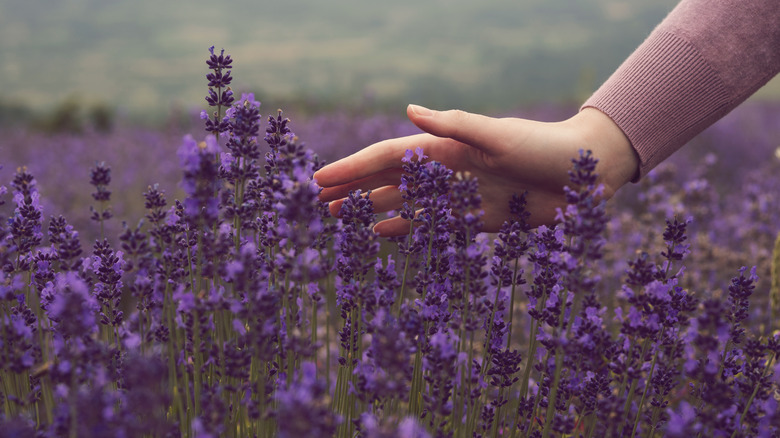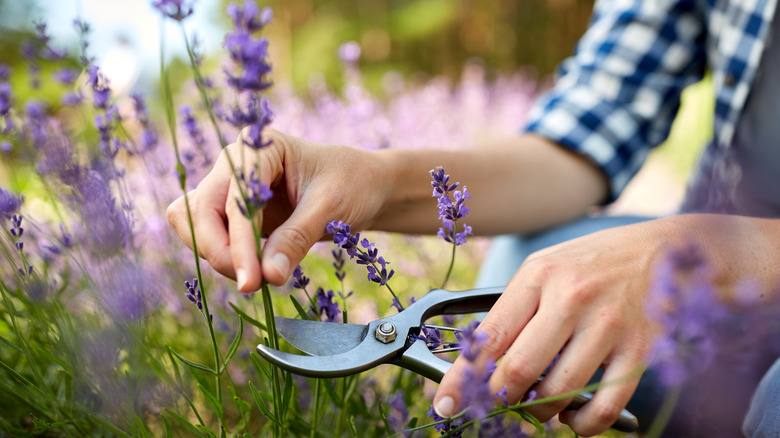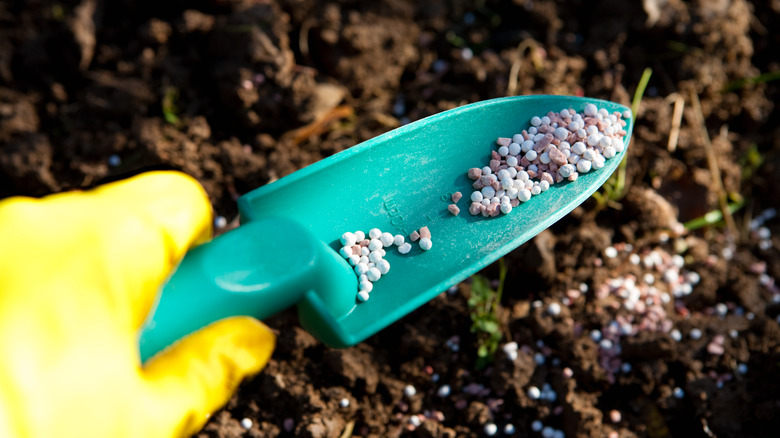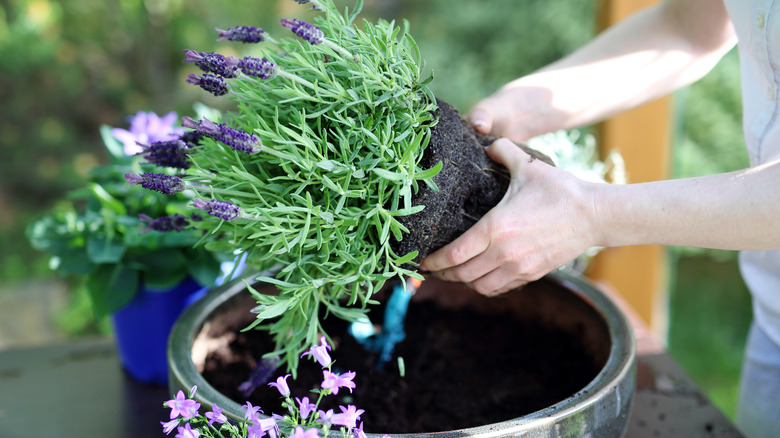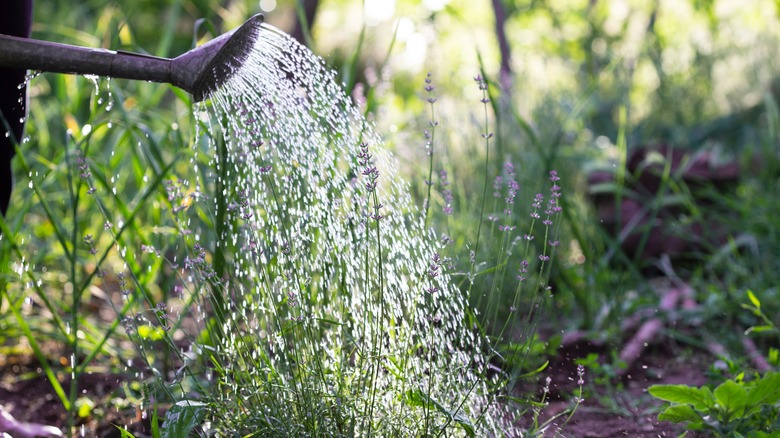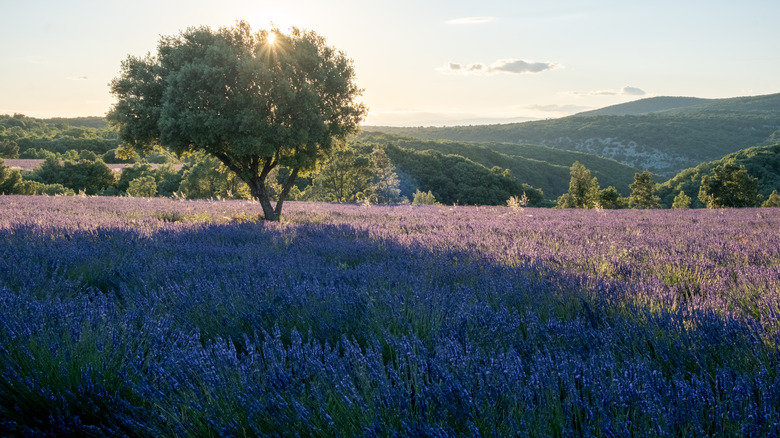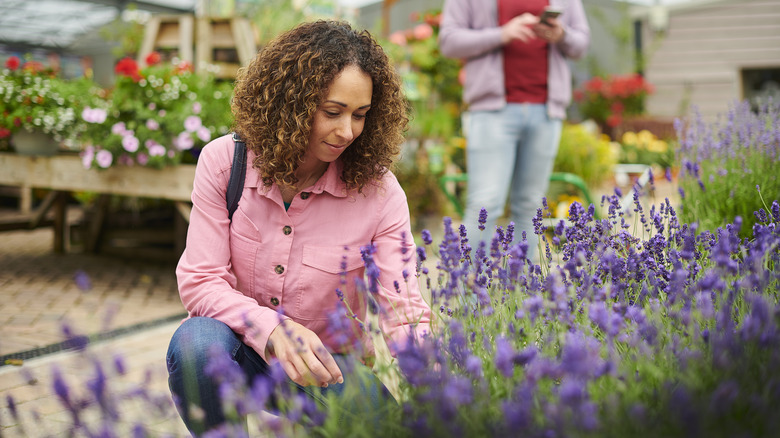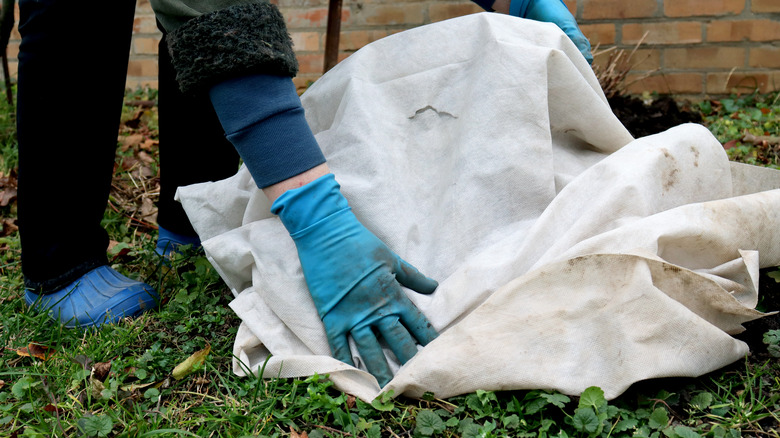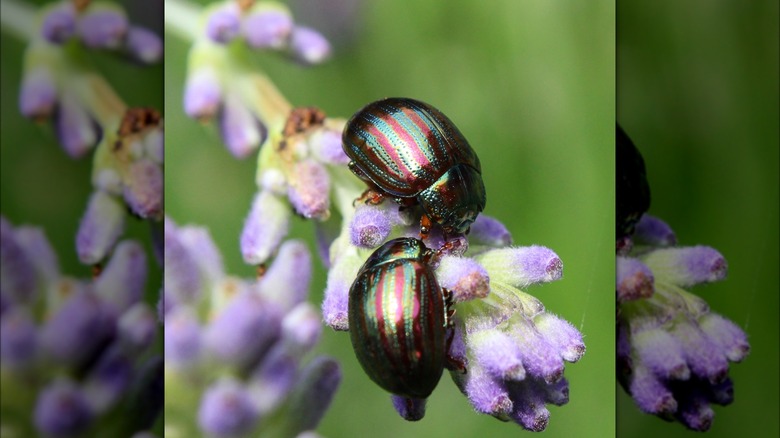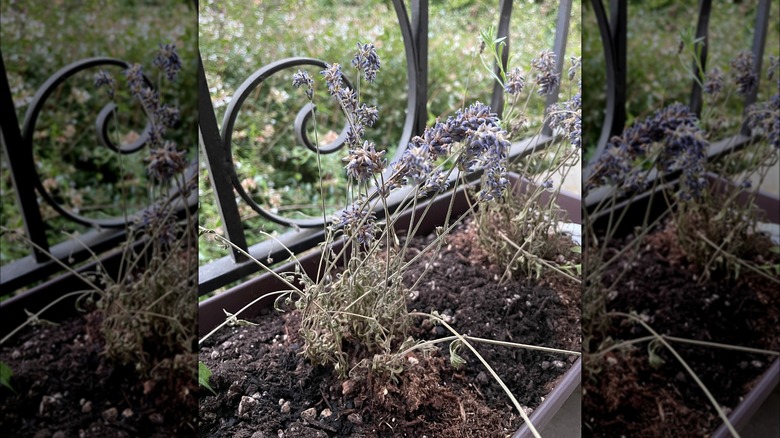Mistakes To Avoid When Growing Lavender
We may receive a commission on purchases made from links.
Lavender offers several benefits to home gardeners. In addition to its fragrant aroma and usefulness in a variety of DIY projects, lavender also repels bugs, is deer resistant, and is relatively easy to grow. If you're thinking about adding some lavender to your home garden, then you're probably excited to reap the benefits in the coming month and enjoy this colorful addition to your home.
However, while lavender is relatively easy to care for compared to houseplants that can be incredibly difficult to grow, it isn't foolproof. There are several common mistakes that gardeners make when growing this herb. And, unless you want your lavender plant to end up droopy, yellow, sad, or even dead, you'll want to learn how to avoid these mistakes in your home garden. Read on to learn how to grow beautiful, vibrant, and healthy lavender that will convince visitors that you have a truly green thumb.
Not knowing how to properly prune it
There are several mistakes home gardeners can make when pruning lavender. One of the most serious ones would be to cut back the woody portion of the plant. You should only cut the green lavender stems, aiming to stay about 3 inches away from the woody portions. Cutting the woody portions will damage the plant, possibly to the point that it won't grow back.
Another mistake to avoid is pruning at the wrong time. If you wait until too late into the fall or at the beginning of winter, it is more likely that the lavender plant will get damaged by frost and colder weather. Instead, prune this plant just after the flowers have stopped blooming, which should be towards the end of the summer or early in the fall. Also, always make sure that your pruning tools are clean. Otherwise, you might spread disease to the lavender. Use a disinfectant to thoroughly clean them.
Improperly fertilizing it
Don't make the mistake of not fertilizing your lavender plant correctly. To start, you must choose the right type of fertilizer for this flower. Any fertilizers that have too much nitrogen or a higher acidity level will not work well. Compared to many other plants, lavender doesn't need a lot of nutrients. And, giving it a fertilizer that is too rich can cause it to grow too quickly. While this may seem like a good problem to have, there won't be as many flowers, so the plant will end up looking less attractive. Instead, opt for a slow-acting, alkaline fertilizer with a lower nitrogen count.
Now that you understand that lavender really doesn't require much fertilizer, this next mistake may make more sense to you. Many people end up adding new fertilizer to their plants too frequently, with some applying it every two weeks or so. This results in an oversupply of nutrients, and will still lead the plant to grow too quickly, but not flower as fully. Assuming the soil conditions are ideal, you should really only fertilize lavender plants about two times each year.
Planting it in the wrong type of soil
Planting lavender in the right kind of soil is essential. The ideal soil for lavender, whether you're growing it in your garden or in pots, will not be overly acidic. It should have a pH between about 6.7 and 7.3. Additionally, the soil should also be well-drained, as too much moisture is not good for this plant. If necessary, consider mixing in some builder's sand, compost, or perlite with your soil before putting the lavender plants in it. The builder's sand will provide more aeration to help it drain better.
If you don't want to mix soil for your plants, keep these criteria in mind when shopping. The Gardenera Organic Lavender Soil Mix or Soil Sunrise Lavender Potting Soil are two premixed options to try. Regardless of whether you end up purchasing a soil mix or blending your own, you might also want to spread a little sand or small rocks around the bottom of each plant. These will help ensure that the water evaporates quickly, protecting the plant from overwatering.
Not watering it properly
When it comes to growing herbs, many people are stumped by how to water them properly. In the case of lavender, less is definitely more. Lavender is a well-adapted and very resistant plant. As with excess amounts of fertilizer, too much water can also threaten its health. If overwatered, lavender may suffer from root rot, causing the plant to die. This is one of the reasons why well-drained soil is essential, but if you're dumping too much water on the plant, it will remain too wet to stay healthy.
The watering requirements will vary some based on where the lavender is planted and whether it is a new or established plant. For example, if you've just planted lavender outside, water it about once every 3 to 7 days. However, if the plant is well-established, cut back to watering it only during droughts when there hasn't been any rain for two weeks.
If you have lavender plants inside your house, they will need to be watered more often. Check moisture levels before watering, and only do so if the soil feels dry. Keep in mind that even if the top of the soil is dry, it might still be moist a few inches down. Dip your finger down into the soil a bit to see if it is wet or dry below the surface before grabbing the watering can.
Planting it in the shade
Look for the best spot in the garden for your lavender plants. The ideal location will be one that is sunny and bright for as much of the day as possible. The plants will need a minimum of 6 hours of direct sunlight to really thrive, but could do even better with closer to 8 or 10 hours during the summer months. Lavender's desire for sun exposure can be understood when you take a look at the origins of the plant. It originally grew along the Mediterranean. This coastal region receives direct sunlight for over half of the year.
Those who live in colder areas or individuals who are potting their lavender plants to grow inside the house can get away with leaving them in more shaded areas during the months when they go dormant. But, if you live in an area with a warmer climate year-round (zones 7 to 10), then you must ensure the plant will receive sufficient sunshine month-in and month-out. Without sufficient sunlight, lavender won't be able to go through photosynthesis to convert light into food, and its health will suffer.
Not choosing the right variety
There are several varieties of lavender. However, you can't simply look at a few pictures or read a couple of names to choose which one you want to grow. Instead, you'll need to consider a range of factors, including the climate where you live, when the plants will flower, and more. When it comes to climate, some varieties are better suited for cooler or drier weather, while others will need more warmth or rain. For example, while French lavender and Spanish lavender do best in Hardiness Zones 8 to 9 where the weather is warmer year-round, English lavender can survive in Hardiness Zones 5 to 9.
You should also consider when you'd prefer the lavender plants to bloom, as the timing will not be identical between the different varieties. English lavender is an early bloomer, typically producing flowers from the end of spring to the middle of summer. Other varieties, such as Lavandin, don't start blooming until the middle of summer, while others like French lavender may produce flowers all year long in the right weather conditions.
Not protecting the plants from frost
If you live in an area with cold winters, you could be making a mistake by not protecting your lavender plants from frost. As alluded to above, different varieties of lavender do better in different climates. If you're trying to grow French lavender, Spanish lavender, or any of the other varieties that do best in warmer climates, you'll definitely want to take some steps to protect the plants. On the other hand, English lavender is a heartier variety that might not need much protection in these colder climates. The exception to this would be the younger plants that will remain more susceptible to damage from frost, wind, and other winter weather.
When cold weather is knocking on the door, cover your lavender plants with a frost cloth — like the Valibe Blanket Plant Covers. If you want to go the DIY route to save some money, you could also use some burlap or extra towels or lighter weight blankets you have around the house. However, you'll want to leave the plant uncovered for the first hard frost of the season. Exposing them to the colder temperatures will alert the plant to switch over to dormancy mode, better protecting it throughout the winter.
Failing to monitor for pests
Some falsely assume that because lavender is relatively resistant to damage from pests, that disaster is never going to strike. However, lavender is resistant — not immune — to pest damage. So, failing to keep an eye out for unwelcome insects could stop you from spotting a small problem before it turns into something bigger.
Whiteflies and aphids are two common pests you'll want to monitor for. These tiny, flying insects suck the sap out from the underside of lavender leaves. During an infestation, they may cause the leaves to yellow or look otherwise unhealthy. Mold may also form on the leaves where the bugs' honeydew secretions are. Try putting some reflective mulch (like this one from MYXC) around your lavender plants to deter white flies, and consider attracting or releasing ladybugs to reduce the aphid population.
Four-lined plant bugs are another pest that doesn't seem to mind lavender's stronger aroma. They like to nibble on newly-grown stems or leaves, which reduces the number of flowers the plant produces. If you see evidence of four-lined plant bugs, consider planting some chamomile or purple prairie clover near your lavender. These plants will attract pirate bugs, damsel bugs, and other natural predators that will devour four-lined plant bugs.
Leaving your plants susceptible to disease
Lavender is also resistant to many plant diseases. But, once again, this doesn't mean it is impossible for your lavender plants to get a disease. The biggest disease that you'll want to take steps to avoid is root rot. As described above, lavender does not need a lot of water. If it gets too much more than it needs, the plant may not get enough oxygen, which can cause the leaves to dry out or turn brown. To avoid root rot, make sure you choose a well-draining soil to ensure as much water is pulled away from the roots as possible. Because root rot is a disease that can be spread from other infected plants, it is also important to make sure you purchase new lavender plants from a reputable location and inspect them for signs of damage before bringing them home.
Another disease to know about is Xylella. Caused by bacteria, this disease is generally passed between plants by sap-sucking insects, like whiteflies. Attractive natural predators, such as dragonflies, by planting companion plants near your lavender can help minimize the chances of Xylella. Following the suggestions recommended above to keep your plants healthy will also help them better fend off any potential diseases.
